| 1 | The black mamba’s closest relative |
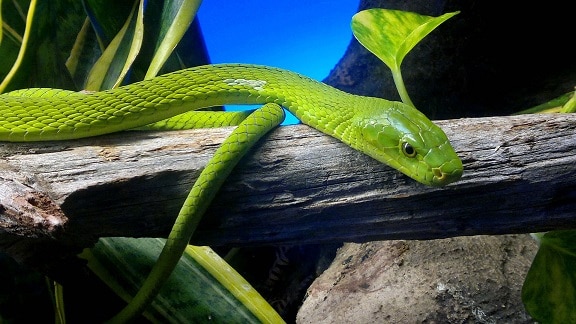
The black mamba might be the worst snake on earth to accidentally bump into. Their venom is horrifically neurotoxic, which they combine with a frenzied, nervous personality. Black mambas occupy a large swathe of sub-Saharan Africa, but less famous is their smaller, more tree-dwelling cousin: the eastern green mamba (Dendroaspis angusticeps).
The green mamba’s first difference is being significantly shorter than its cousin. Black mamba measure 3-4 metres, and are the second largest venomous snake on Earth, but green mambas reach a maximum of just 2.3 metres, with an average of 1.5 metres (which is still fairly large).
Their territory in Africa is far more restricted, as green mambas appear in just 5 countries: South Africa, Mozambique, Zimbabwe, Kenya and Tanzania. Within those realms, they tend to hug the eastern coasts, never appearing in savannahs deeper within the country.
The Dendroaspis mamba genus has 4 species in total, with the remaining two being the Jameson’s mamba and western green mamba. In 2016 though, a colossal evolutionary tree of all snakes was released, produced through years of hard genetic testing. This revealed that eastern green mambas are in fact the black mamba’s closest living relative. Green mambas are simple to distinguish, as they’re always a vivid leafy green, except as newborns when they’re bluish-green.
| 2 | Prefers forests to savannah |
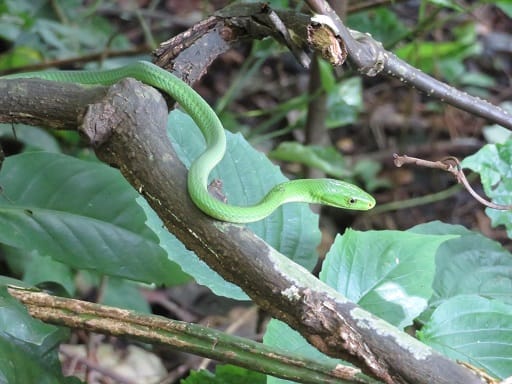
Compared to its cousin, green mambas are far more of a tree snake. Black mambas can be found slithering through open savannah and fields, duelling mongooses and honey badgers. Meanwhile, the green mamba always appears in forests or tree clumps, and are a shier, more elusive snake which prefers to stay hidden in a disguising cloak of foliage.
Green mambas are most abundant in tropical coastal forests, at altitudes below 500 metres. They also appear in woodland and coastal bush, or even garden hedges in rural villages. Relatively untamed agriculture isn’t a problem, as green mambas have been spotted in coconut, mango, cashew and citrus plantations. They also take shelter in rural roofs, particularly those made from coconut thatch.
The green mamba rests on branches for most of the day, straying to the ground and crossing roads very occasionally. They’re an ambush snake which utilise the disguise of swaying overlapping branches, making them hard to spot even when humans walk directly below their tree. Though normally moving patiently, green mambas can be fast and explosive when aggravated.
| 3 | Causes very few deaths |
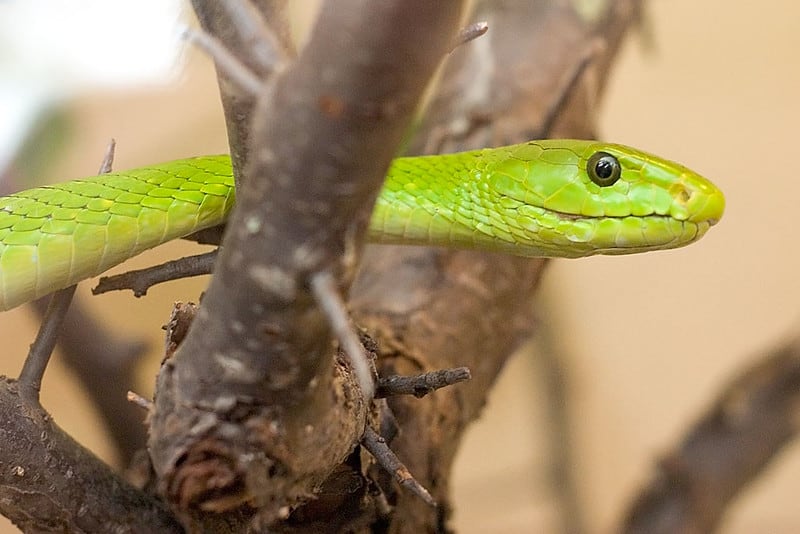
Green mambas move completely by day (diurnal), and have a less aggressive personality than their cousin. Compared to black mambas, they rarely gape their mouth wide in an intimidating display, preferring to flee deeper into their curtain of greenery. It’s the same story with their venom: deadly, but not utterly terrifying.
Put simply, black venom has an LD50 score of 0.05mg, which is the third or fourth strongest land snake. Its venom yield is a strong 50-100mg per bite. The green mamba, meanwhile, has an LD50 score of 0.26mg, which still outstrips most rattlesnakes, but is clearly a rung below its cousin. The venom yield is fairly similar, at 60-95mg per bite.
Green mambas make up only a small percentage of local snakebite statistics. From 1957 to 1979, 2552 snakebites were recorded in hospitals across South Africa. Of those, 17 were the green mamba. 10 suffered systemic symptoms, and no patients succumbed and died. The most frequent biters were the puff adder (401), followed by the night adder (146) and rinkhals (141). Similarly, a 2022 study found that puff adders ruled the roost in Mozambique.
| 4 | Contains rare toxins (fasciculins) |
Despite being its closest living relative, green mamba venom is surprisingly different to its cousin. For one thing, the venom contains virtually no alpha-neurotoxins. This is the destructive class that induces full body paralysis, the very reason why black mambas are so notorious. They’re the class that honey badgers and mongooses are famously resistant to, allowing them to duel black mambas in the savannah while wildlife photographers keenly snap images.
Alpha-neurotoxins completely block nicotinic acetylcholine receptors at the neuromuscular junction, preventing brain signals from being transmitted, and causing complete neuromuscular shutdown in just tiny doses. Black mambas contain the most powerful alpha-neurotoxins of any African snake, yet the green mamba totally lacks them. Either the black mamba gained them after the species diverged, or the opposite – green mambas gradually lost them after taking to the trees.
Instead, green mambas contain their own unique neurotoxin family: the fasciculins. These are named after muscle fasciculations, AKA twitching muscles, an often benign condition which can be caused by stress or drinking too much caffeine, but also neurological issues. Twitching muscles are a classic early symptom of green mamba envenomation, and fasciculins achieve this by deactivating the enzyme acetylcholinesterase. This enzyme normally degrades acetylcholine, the transporter of brain signals to muscle receptors. Excess acetylcholine then builds up, causing muscles to twitch and spasm, from eyelids to legs.
Convulsions are another green mamba symptom, yet full body paralysis is rare. Black mamba victims can sometimes be fully immobile, like a statue, yet able to see and hear ever word around them.
| 5 | Synergistic toxins |
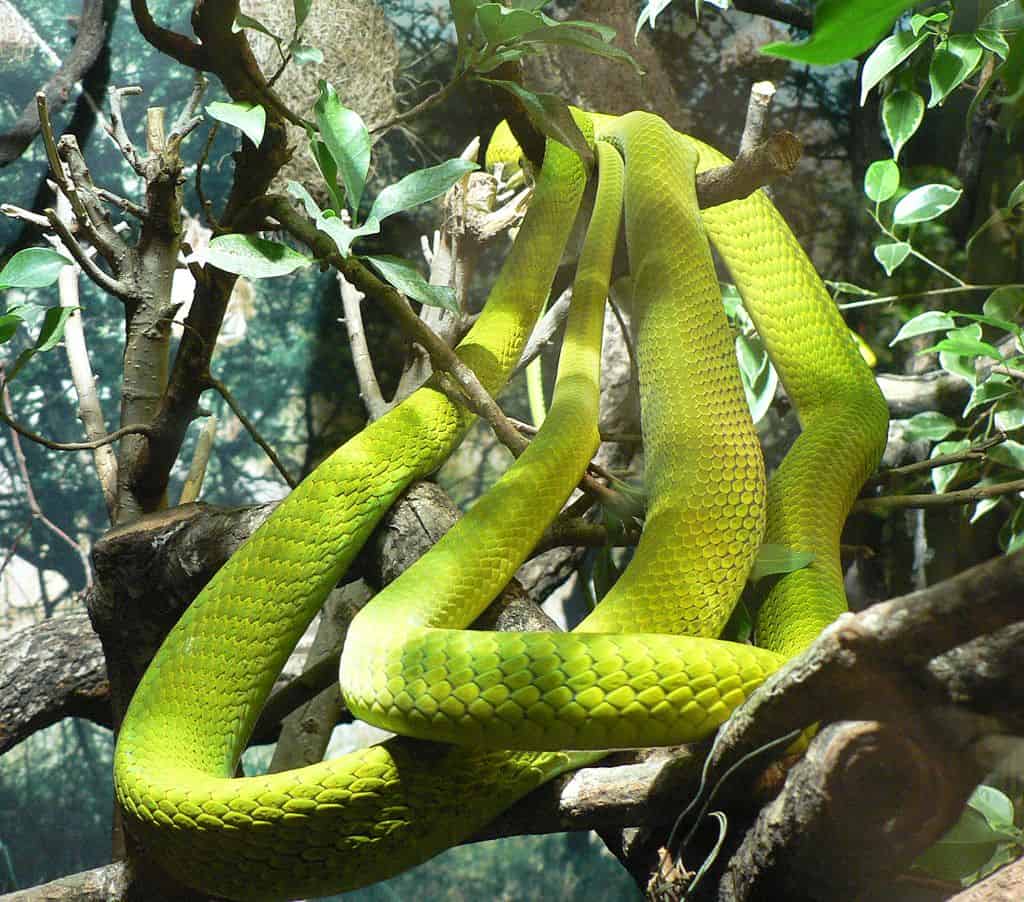
In 2016, scientists examined green mamba venom in the highest detail so far. They identified 42 proteins, and isolated over 15 venom fractions, each representing a slice of the toxin makeup. A Toxicity Scale was used, whereby 7 was the potency required to have lethal properties.
Only one fraction scored above 7: the fraction containing fasciculin-2, the toxin previously proven to overexcite muscles by blocking acetylcholinesterase. On the Toxicity Scale, this fraction scored 10.9, yet the complete venom scored 117.6, despite most fractions failing to reach the danger threshold. The complete venom was far stronger than suggested by individual portions in lab tests.
There was only one explanation: that the toxins were acting synergistically, in a dance of death that brought each other above the danger threshold via complex interactions. Another class, the dendrotoxins, was thought to be interacting with the fasciculins. The same study found that green mamba venom killed lab mice in an average of 10 minutes.
| 6 | The least deadly mamba |
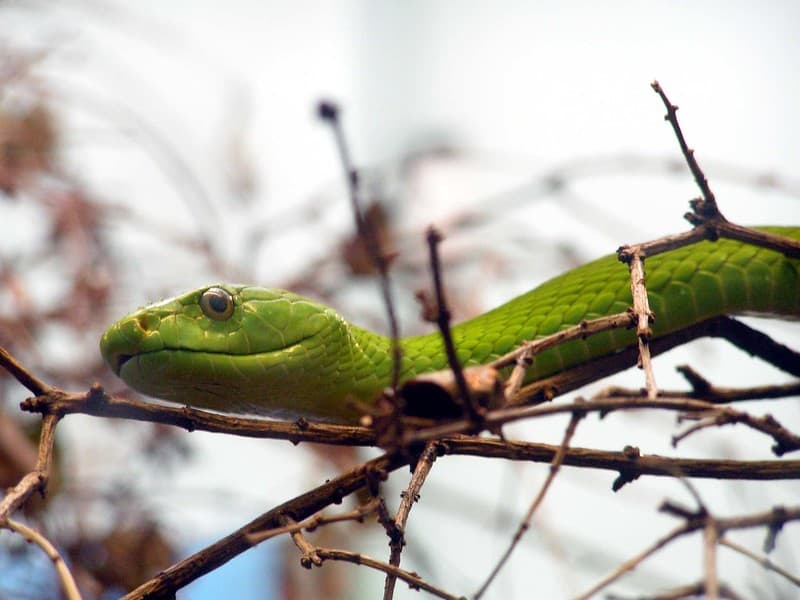
In 2018, a study answered the only question that really mattered: the ranking of the mamba family. The black mamba ranked first for raw venom potency, with an LD50 score in mice of 0.33 µg/g. In second was the eastern black-tailed subspecies of Jameson’s mamba (0.53 µg/g), followed by the main Jameson’s mamba subspecies (1.20 µg/g), and the western green mamba (1.14 µg/g) at an approximate tie. Green mamba venom was easily the weakest at 1.99 µg/g.
Despite this, green mambas are classified as a category 1 snake by the World Health Organisation, one with the highest deadliest potential. The symptoms include dizziness, swelling of the bite site, nausea, irregular heartbeat, difficulty breathing, and potentially death via respiratory paralysis in the most serious cases. Systemic symptoms can show up in just 30 minutes.
Green mamba venom also contains metalloproteinases, the class which physically tears through skin tissue, but in a small percentage of 6.7%. The deadly Bothrops moojeni of southern Brazil reaches 39%. Consequently, a green mamba’s venom causes only mild local damage. A sneakier ingredient is adenosine, a vasodilating substance, which is believed to allow faster dispersal of the venom throughout the body. Black mamba venom also contains adenosine.
| 7 | Their secret daily cycle |
In 1994, a study spent 27 days analysing the green mamba’s movements in detail, in a coastal forest of Kenya, just 5km away from the Indian ocean. 2 green mambas were implanted with tiny radio transmitters, and were monitored daily for sessions ranging from 1-6 hours. They found a consistent daily pattern, where the green mambas would descend to the lower branches in the morning, before retreating high into the canopies at midday.
On a normal day, a green mamba would move less than 5 meters. They would stay in one tree perch for 6-10 days, before embarking upon a mini quest to find a more favourable tree, moving an average of 20.84 metres per quest. During these mini expeditions, they always stayed within the tree canopy. The scientists made no observations of the green mambas dropping to the ground.
Proving what people had already suspected, the green mamba was a sluggish snake. On 29.2/46.8% of days (for each snake), the observed mambas moved less than 3 metres. Over the 27 day study, the mean daily movement for the pair was calculated at just 5.4 metres.
| 8 | Diet: birds and mammals |
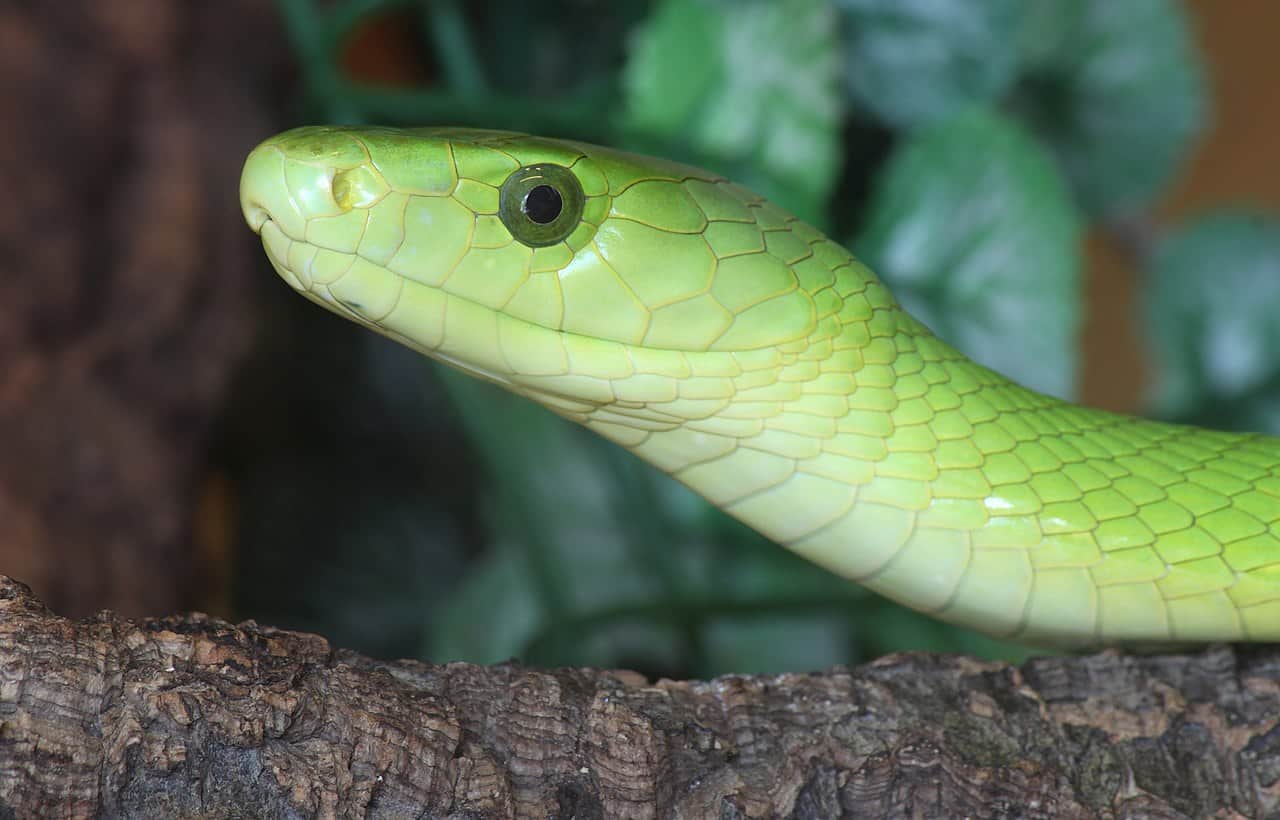
Dendroaspis angusticeps also has a different diet to its cousin. Black mambas lean heavily towards mammals, as a 1996 study found a makeup of 81.48% mammals and 14.81% birds. The majority of the birds were chicks and fledglings. Meanwhile, being a tree dweller, the green mamba is roughly similar, but leaning more heavily towards birds, at 42.1% of meals. Species include the greenbul, cape white eye, African starling and red-billed quelea.
Despite being an arboreal snake, green mambas somehow eat many ground-dwelling rodents such as creek rat and bushveld gerbil. They may venture to the ground more commonly than thought, or may have incredibly sharp reflexes and pounce the very second a rodent dares to climb their tree.
Green mambas are mainly an ambush snake, but can forage actively as well. They’ve been observed raiding birds’ nests, and even systematically hunting bats over several days. One of their most cunning tendencies is to position themselves in neem trees, which bear small orange fruits which birds are highly attracted to. Disguised by their green colours, the green mamba pounces the moment the bird strays too close.
| 9 | Commonly misidentified |
Green mambas can occasionally swell to huge concentrations, particularly in southeast Kenya and Tanzania. 200-300 per square kilometre have been observed in some locales. Green mambas lay 4-17 eggs, usually in leaf litter or tree hollows. These measure 30-60mm, and the hatchlings crawl out at 30-45cm. Green mambas have a decent lifespan, as the record was 18.8 years in captivity, and 14 years for another captive.
Green mambas have round pupils rather than vertical, and their bodies have no patterns, just a consistent sea of grassy green. Their bellies are a slightly paler green than their bodies.
This deadly snake is incredibly easy to confuse with other green snakes in southern Africa, including spotted bush snakes, eastern natal green snakes, boomslangs, etc. There’s too many differences to list here. So two easy ones are that green mambas are the longest, and have the smallest eyes of the local green snakes. For the rest, check out this handy graphic.
| 10 | Known hotspots in Africa |
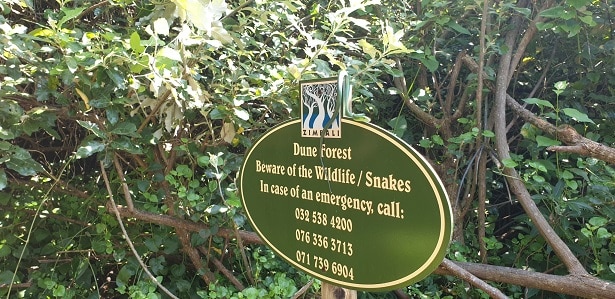
Green mambas were also the subject of one of the great snake photos. It was taken near Durban, South Africa, less than 1km from the coastline. The Zimbali Coastal Estate is a luxury resort, for international tourists and wealthy Africans alike, and one way to really get the African experience is to bump into the many green mambas lurking in its forests. “Beware of the Wildlife/Snakes” the sign warned, before providing tourists with a phone number in case of life-threatening envenomation. As if to emphasise the point, a green mamba was draped around the top of the metal sign. Its tail was covering the logo, and its facial expression was neutral, as though not desperate to bite, but perfectly willing to if the situation arose.
Other hotspots for green mambas include near Mount Meru and southern Mount Kilimanjaro in Tanzania. In Kenya, they’re abundant in Kibwezi, Meru National Park and Nyambene Hills, and Boni Forest along the Kenyan/Somali border.
Somewhere you won’t find them is the famous Kruger National Park of South Africa, as this is too far inland. Seaside villages seem particularly plagued by this snake, as this one in Watamu, Kenya was found less than 1km from the Indian ocean.
